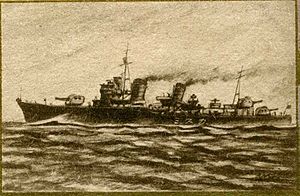Japanese destroyer Kasumi (1937)

| |
| History | |
|---|---|
| Name | Kasumi |
| Ordered | 1934 Maru-2 Program |
| Builder | Uraga Dock Company |
| Laid down | 1 December 1936 |
| Launched | 18 November 1937 |
| Commissioned | 28 June 1939 |
| Stricken | 10 May 1945 |
| Fate | Sunk, 7 April 1945 |
| General characteristics | |
| Class and type | Asashio-class destroyer |
| Displacement | 2,370 long tons (2,408 t) |
| Length |
|
| Beam | 10.3 m (33 ft 10 in) |
| Draft | 3.7 m (12 ft 2 in) |
| Installed power | 51,000 shp (38,031 kW) |
| Propulsion | 2-shaft geared turbine, 3 boilers |
| Speed | 34.85 knots (40.10 mph; 64.54 km/h) |
| Range | |
| Complement | 230 |
| Armament |
|
Kasumi (霞, "Haze")
History
Kasumi was the ninth of ten Asashio-class destroyers built for the Imperial Japanese Navy.
The Asashio-class destroyers were larger and more capable that the preceding Shiratsuyu-class, as Japanese naval architects were no longer constrained by the provisions of the London Naval Treaty. These light cruiser-sized vessels were designed to take advantage of Japan’s lead in torpedo technology, and to accompany the Japanese main striking force and in both day and night attacks against the United States Navy as it advanced across the Pacific Ocean, according to Japanese naval strategic projections.[2] Despite being one of the most powerful classes of destroyers in the world at the time of their completion, none survived the Pacific War.[3]
Kasumi, built at the
Operational history
At the time of the
In January 1942, Kasumi escorted aircraft carriers
On 1 September 1943, as part of Desdiv 9, Desron 1 of the
Kasumi was returned to patrols of the northern approaches to Japan in February, escorting a troop convoy to Uruppu in late March and returning with the cruisers Nachi and Ashigara to Kure at the start of August.
During the
In February 1945, Kasumi escorted the battleships Ise and Hyūga from Singapore to Kure. She was reassigned to the IJN 2nd Fleet on 10 March.
On 6 April 1945, Kasumi was part of the escort for the
See also
- Operation Kita
- List of ships of the Japanese Navy
Notes
- ^ Nelson. Japanese-English Character Dictionary. page 946
- ^ Peattie & Evans, Kaigun .
- ^ Globalsecurity.org, IJN Asashio class destroyers
- ^ Nishidah, Hiroshi (2002). "Asashio class 1st class destroyers". Materials of the Imperial Japanese Navy. Archived from the original on 2012-07-21. Retrieved 2011-03-24.
- ^ Allyn D. Nevitt (1998). "IJN Kasumi: Tabular Record of Movement". combinedfleet.com.
- ISBN 9781557049131.
- ISBN 1-55750-914-X.
References
- D'Albas, Andrieu (1965). Death of a Navy: Japanese Naval Action in World War II. Devin-Adair Pub. ISBN 0-8159-5302-X.
- Brown, David (1990). Warship Losses of World War Two. Naval Institute Press. ISBN 1-55750-914-X.
- Feifer, George (2001). "Operation Heaven Number One". The Battle of Okinawa: The Blood and the Bomb. The Lyons Press. ISBN 1-58574-215-5.
- ISBN 0-345-27894-1.
- Howarth, Stephen (1983). The Fighting Ships of the Rising Sun: The Drama of the Imperial Japanese Navy, 1895–1945. Atheneum. ISBN 0-689-11402-8.
- Jentsura, Hansgeorg (1976). Warships of the Imperial Japanese Navy, 1869–1945. US Naval Institute Press. ISBN 0-87021-893-X.
- Nelson, Andrew N. (1967). Japanese–English Character Dictionary. Tuttle. ISBN 0-8048-0408-7.
- Watts, Anthony J (1967). Japanese Warships of World War II. Doubleday. ISBN 978-0-3850-9189-3.
- Whitley, M J (2000). Destroyers of World War Two: An International Encyclopedia. London: Arms and Armour Press. ISBN 1-85409-521-8.
